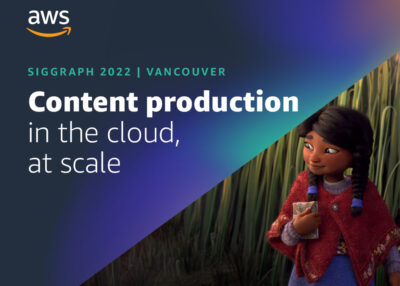Deadline render farm management software has always been about simplifying the data-intensive and herculean final step of the visual effects (VFX) process. Born out of production, the Amazon Web Services (AWS) Thinkbox product has played a crucial role in modern filmmaking as projects feature an increasing amount of computer graphics (CG) for everything from hero shots to set extensions and background elements.
Ahead of this year’s SIGGRAPH conference in Vancouver August 8-11, AWS has announced that AWS Thinkbox software tools, including Deadline, are now free of charge. For more information about AWS at SIGGRAPH 2022, visit the AWS event page or see their team at SIGGRAPH, booth 602.
Designed from the ground up by VFX professionals, Deadline arrived at a critical time in the evolution of VFX, helping solve rendering hurdles that only multiplied as the scope of digital work expanded. How compute resources are managed can make or break a project, especially as VFX shots grow in complexity and creative decisions are made closer to release dates, leaving a limited timeline for rendering. As more studios embraced off-the-shelf tools over larger proprietary systems to meet this demand, dynamic pipelines began to emerge that let artists choose the best creation tool for the task at hand. Deadline was the first to take the headaches out of seemingly endless batch rendering, a compute-intensive process that often meant sleeping on a studio couch while babysitting render farms.
Although it began as a Windows-only way to solve a specific set of workflow issues on a single film, Deadline is now many things to artists and supervisors across the pipeline. The highly stable, scalable, and flexible tool supports more than 100 content creation applications as well as Windows, Linux, and Mac OS. It is respected throughout the industry and widely used to efficiently manage the substantial compute power needed to render the high-impact VFX and animation created by Walt Disney Studios, ILM, DNEG, and Framestore, among many others.

Deadline was originally developed at Frantic Films by co-founders Chris Bond and Ken Zorniak who broke into feature film VFX in 2001 with the action blockbuster Swordfish. Multiple pain points across their Swordfish pipeline convinced Bond to search for a better way to render future projects. Bond wanted his team, each working in various content creation tools, to be able to access the studio’s render farm at any point in the process. When he couldn’t find the render management solution he was looking for, he decided to build it, and the company launched an R&D division. From there, Deadline was born and eventually made available to other studios. Long before cloud computing was widely used in entertainment, the team made sure that Deadline integrated seamlessly with traditional independent software vendors (ISVs) and was one of the first tools to work with emerging cloud providers. This made Deadline’s eventual integration with the larger AWS family of cloud computing products a natural part of its evolution as a compute management tool.
With more than two decades of simplifying rendering, VFX, and simulation workflows, Deadline is now available at no cost, along with other AWS Thinkbox products (Draft, Krakatoa, Frost, XMesh, Sequoia, and Stoke).
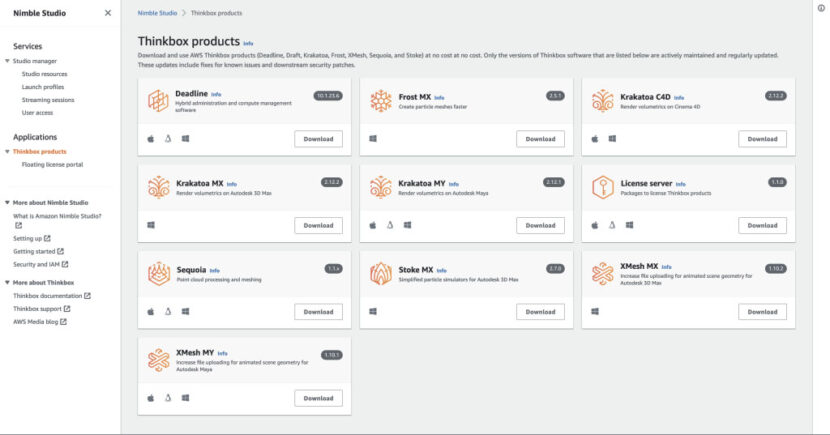
21 years : Here is a look back at some of the render tool’s significant milestones along the way.
2001
Frantic Films officially opens its new R&D unit, setting a goal of creating both commercial-grade and in-house VFX tools that simplify and synchronize VFX pipelines.
2002
Frantic uses its earliest version of Deadline to manage renders on The Core (2003), a sci-fi film starring Hilary Swank, Aaron Eckhart, and Stanley Tucci.
2003
Now officially named Deadline, the in-house tool begins to flex its muscles. During the year, Frantic uses it to render the VFX and animation sequences for X2:X-Men United, The Italian Job, Paycheck, and Scooby-Doo 2.
2004
Available for public beta testing that spring, Deadline makes its commercial product debut in August. This early version featured extensive out-of-the-box support for widely used applications like 3ds Max, After Effects, Combustion, Digital Fusion, Maya, Photorealistic RenderMan, and more. It also shipped with two SDKs (scripted and C++) so customers could write their own plug-ins. Video game developer Blizzard Entertainment becomes the tool’s first official external client.
2006
Deadline 2.0, features a new Power Management feature that helps reduce energy consumption by selectively powering down machines based on the render queue.
2007
Prime Focus Group acquires Frantic. The earliest features of remote rendering appear, letting artists launch jobs in Los Angeles and render them on a render farm in Canada.
2008
Deadline 3.0’s addition of Linux, Mac OS, and 64-bit to its original Windows support dramatically expands the tool’s reach.
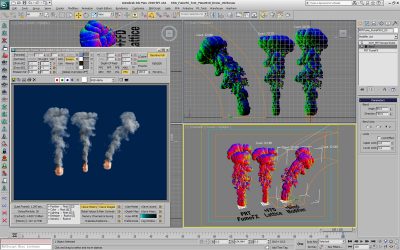
2010
Deadline 4.0 is focused on network load reduction, ensuring that the render farm stays responsive while working with increasingly expanding data sets. Chris Bond reacquires Deadline and launches Thinkbox Software.
2011
Deadline integrates with Shotgun (now rebranded as ShotGrid and owned by Autodesk) for seamless renders and better production tracking and render queue management. Later that summer, the Deadline 5.1 beta, with native Python support, is announced. Now, multiple workers can launch Deadline from a single machine.
2012
Deadline 6.0 arrives with a redesigned GUI and new back-end architecture to make it more scalable and secure. Cloud support, access to Amazon Elastic Compute Cloud (Amazon EC2), becomes a reality.
2014
The Deadline 6.1 release, with OpenEXR support, provides several new features for automating post-render tasks. The Deadline 7 beta, which officially releases by the end of the year, includes built-in support for virtual machine extension (VMX) and fTrack. Workers can launch Deadline on schedule or when their machine becomes idle.
2015
The subsequent point releases of Deadline 7 let customers easily create movies from their rendered images or perform file conversions.
2016
Deadline 8.0 is released, introducing usage-based licensing for Deadline and third-party creative applications, available for purchase via the Thinkbox Marketplace. Usage is tracked per minute and can be consumed alongside existing floating licenses.
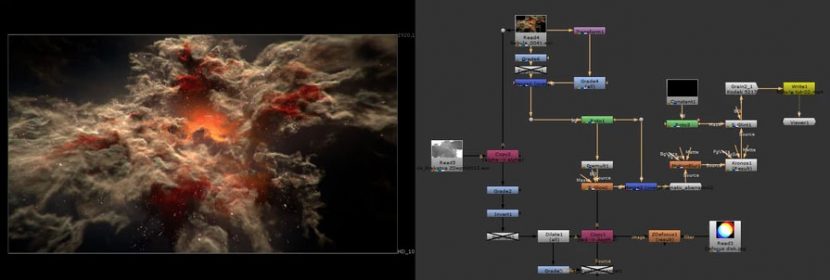
2017
Thinkbox Software was acquired by AWS, and, as a result, Deadline was closely integrated with AWS, providing free render management for users of Amazon compute resources. In the same month, Thinkbox released Deadline 9.0, which introduces a Pipeline Tools interface for post-processing and project management, with many options for popular platforms and plug-ins. Deadline also added a file system that automatically syncs asset files to Amazon Simple Storage Service (Amazon S3), further streamlining in-studio and cloud-based workloads. Later that year, the Deadline 10.0 release includes AWS Portal. The release also introduces dynamic license switching.
2019
A point release of Deadline 10 includes Resource Tracker, a cloud-based monitor that automatically terminates unhealthy instances, helping studios avoid unnecessary costs.
2020
AWS releases Render Farm Deployment Kit (RFDK), an open-source software development kit that can be used to deploy, configure, and manage your render farm infrastructure in the cloud. It supports render farms built using Deadline, allowing users to easily go from nothing to a production-ready render farm in the cloud.
2022
AWS offers Deadline as a free download, a bonus to artists and studios large and small who have relied on it to efficiently and effectively manage their compute resources for nearly 20 years.
Whether located on-premises in one location, across multiple facilities, in the cloud, or in a hybrid setup, Deadline technology has been instrumental in allowing studios to scale and collaborate across locations as remote workflows become the norm.
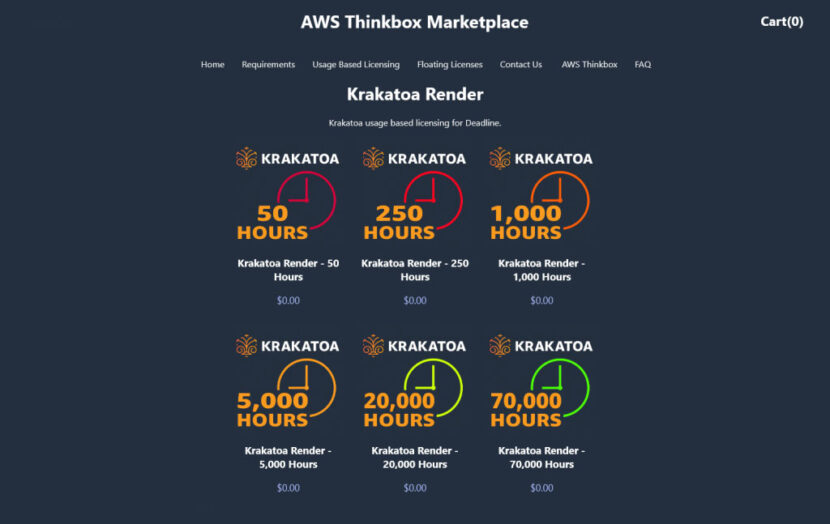
Above is the UI for Krakatoa control in Thinkbox. Krakatoa was designed to process and render millions and even billions of particles, AWS Thinkbox Krakatoa provides a pipeline for acquiring, caching, transforming, modifying, shading, and rendering vast quantities of particles. For many years now, Krakatoa has aided artists in render natural phenomena like dust, smoke, ocean foam, viscous liquids, and even solid objects to production quality standard. Since being invented, Krakatoa has been used in-production to generate visual effects and elements for movies like Avatar, Harry Potter And The Deathly Hallows 2, The Avengers and Star Trek: Into Darkness.

